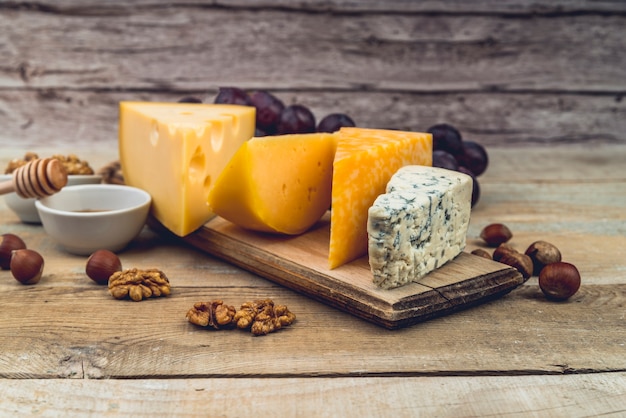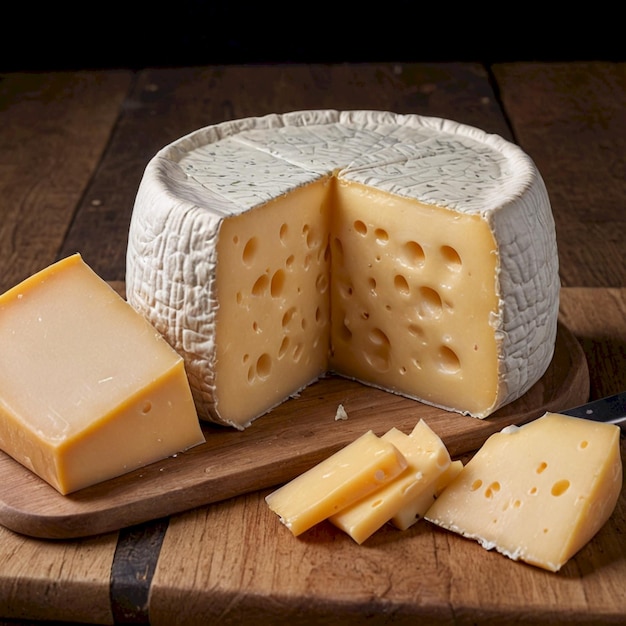Uncategorized
The Ultimate Guide to Gruyère Cheese: Discover Its Rich History, Unique Characteristics, and Culinary Uses
Published
8 months agoon

Gruyère cheese, renowned for its rich, nutty flavor and exceptional melting qualities, has captured the hearts and palates of cheese enthusiasts around the world. This iconic Swiss cheese, named after the town of Gruyères in Switzerland, boasts a storied history and a unique profile that sets it apart from other cheeses. In this comprehensive guide, we delve into every aspect of Gruyère cheese, from its origins and production methods to its diverse culinary applications.
Historical Background of Gruyère Cheese
Gruyère cheese dates back to the 12th century, with its origins deeply rooted in the alpine region of Switzerland. The cheese is named after the medieval town of Gruyères, situated in the canton of Fribourg. Historically, Gruyère was produced by local farmers who used milk from cows grazing on the lush, high-altitude pastures. The cheese’s unique flavor and texture were a result of these distinct environmental conditions, coupled with traditional cheese-making techniques passed down through generations.
The Production Process of Gruyère Cheese
Traditional Cheese-Making Techniques
The production of Gruyère cheese involves a meticulous process that ensures its distinctive qualities. It starts with high-quality, raw cow’s milk, which is heated and combined with rennet to initiate coagulation. The curds are then cut into small pieces and cooked to release whey. The resulting curds are placed into molds and pressed to form the cheese’s characteristic shape.
Aging and Curing

Gruyère cheese undergoes a rigorous aging process, typically lasting between 5 to 12 months. During this time, the cheese develops its complex flavors and firm texture. The aging process takes place in specialized cheese cellars, where the cheese wheels are regularly turned and brushed to develop their rind and ensure even maturation. The climate and conditions in these cellars are carefully controlled to achieve the optimal balance of flavor and texture.
Characteristics of Gruyère Cheese
Flavor Profile
Gruyère cheese is celebrated for its rich, nutty flavor with subtle notes of caramel and a hint of earthiness. Its taste can vary depending on the aging process, with younger Gruyère exhibiting a milder flavor and aged varieties offering a more intense, robust taste. The cheese’s flavor profile is influenced by the milk used, the cheese-making process, and the conditions of the aging environment.
Texture and Appearance
The texture of Gruyère cheese is firm and slightly granular, with a smooth, creamy mouthfeel. The cheese typically features a golden-yellow rind and a pale, ivory-colored interior. As Gruyère ages, it develops small, characteristic holes known as “eyes,” which contribute to its distinctive texture and appearance.
Culinary Uses of Gruyère Cheese
In Classic Swiss Dishes
Gruyère cheese is a staple ingredient in traditional Swiss cuisine. It is famously used in dishes such as fondue and raclette, where its excellent melting properties and rich flavor enhance the overall dining experience. In fondue, Gruyère is combined with other cheeses and white wine to create a smooth, creamy dip perfect for bread and vegetables. In raclette, the cheese is melted and served over boiled potatoes, pickles, and cured meats.
In Gourmet Recipes
Beyond Swiss classics, Gruyère cheese is a versatile ingredient in a variety of gourmet recipes. Its melting qualities make it an excellent choice for soups, quiches, and gratin dishes. Gruyère adds depth and richness to recipes like French onion soup, where it is melted over the top of the soup, creating a golden, crispy crust. It also works beautifully in a savory cheese soufflé or as a topping for stuffed mushrooms.
In Baking and Cooking
Gruyère cheese’s melting properties also make it a popular choice for baked goods and cooked dishes. It can be incorporated into cheese breads, scones, and pastries to add a layer of flavor and moisture. In savory baked dishes, Gruyère can enhance the flavor of casseroles, potato gratins, and macaroni and cheese.
Pairing Gruyère Cheese with Wine and Other Foods
Wine Pairings
Gruyère cheese pairs wonderfully with a variety of wines. The cheese’s nutty, rich flavor complements white wines such as Chassagne-Montrachet or Gewürztraminer. For red wine enthusiasts, a Pinot Noir or a Merlot provides a harmonious balance with Gruyère’s taste profile. The key is to choose wines that will not overpower the cheese but rather enhance its nuanced flavors.
Food Pairings
Gruyère cheese can be paired with a range of accompaniments to create a well-rounded tasting experience. Fresh fruits such as apples, pears, and grapes provide a refreshing contrast to the cheese’s richness. Nuts, like almonds and walnuts, add a crunchy texture that complements Gruyère’s smoothness. Additionally, artisan breads and crackers serve as excellent vessels for enjoying the cheese on a charcuterie board.
Health Benefits of Gruyère Cheese
Nutritional Value
Gruyère cheese is not only delicious but also offers several health benefits. It is a good source of calcium, essential for maintaining strong bones and teeth. The cheese also provides protein, which is important for muscle repair and growth. Additionally, Gruyère contains vitamin A and vitamin B12, which support overall health and well-being.
Moderation and Balance
While Gruyère cheese is nutritious, it is important to consume it in moderation due to its high fat and sodium content. Incorporating Gruyère into a balanced diet can provide enjoyment while maintaining overall health. Enjoying it as part of a varied diet ensures you reap the benefits of this flavorful cheese without excess.
Conclusion
Gruyère cheese stands out as a remarkable product of Swiss tradition, renowned for its rich flavor, exceptional melting qualities, and versatility in the kitchen. Whether you are savoring it in a classic fondue, incorporating it into gourmet recipes, or pairing it with fine wines, Gruyère offers a culinary experience that is both delightful and memorable. Its storied history, meticulous production process, and distinctive characteristics make it a cheese worth exploring and enjoying.
You may like
Uncategorized
Brango Casino: Your Ultimate Guide to Online Gaming Excellence
Published
8 months agoon
September 25, 2024
Introduction to Brango Casino
In the ever-evolving world of online casinos, Brango Casino has distinguished itself as one of the premier platforms for gaming enthusiasts. Established with a commitment to delivering an exceptional gambling experience, Brango Casino offers a wide array of games, exciting bonuses, and a secure platform for players around the globe. In this article, we’ll take a deep dive into the features that make Brango Casino stand out from the crowd and why it deserves your attention if you are looking for a top-tier online casino.
Game Selection at Brango Casino
One of the key reasons why Brango Casino is so popular is its vast selection of games. Whether you are a fan of slots, table games, or live dealer games, Brango Casino has something for everyone. Their game library is powered by RealTime Gaming (RTG), a renowned software provider known for high-quality graphics, immersive gameplay, and innovative features.
Slot Games
Slots are the highlight of Brango Casino, with hundreds of titles available for players to enjoy. From classic 3-reel slots to modern 5-reel video slots, the variety is impressive. Players can also explore progressive jackpot slots, where winnings can reach life-changing sums. Popular titles include:
- Asgard Deluxe
- Cash Bandits 3
- Ninja Star
These games offer unique themes, engaging features, and a chance to win big with every spin.
Table Games
For those who prefer strategic gameplay, Brango Casino offers a wide selection of table games. From Blackjack to Roulette, and Baccarat to Craps, there’s no shortage of options for players who love the thrill of traditional casino games. Each game offers various betting options, ensuring both casual players and high rollers can enjoy their experience.
Live Dealer Games
If you’re looking for the most immersive experience possible, Brango Casino’s live dealer games bring the casino floor directly to your screen. Featuring real dealers and live-streamed games, players can interact with dealers in real-time while enjoying games like Live Blackjack and Live Roulette. This section of the casino adds a personal touch and creates a more social gaming environment.
Brango Casino Bonuses and Promotions
Brango Casino is known for offering some of the best bonuses and promotions in the industry, helping players maximize their winning potential. New players can take advantage of a generous welcome bonus, while regular players can enjoy ongoing promotions and loyalty rewards.
Welcome Bonus
Upon signing up at Brango Casino, new players are greeted with a welcome bonus package that boosts their initial deposits. This bonus often includes a match bonus, where the casino matches a percentage of your deposit, providing you with additional funds to play your favorite games. Players can also receive free spins, allowing them to try out popular slot games without risking their own money.
Ongoing Promotions
In addition to the welcome bonus, Brango Casino runs numerous ongoing promotions. These can include:
- Weekly deposit bonuses
- Free spins promotions
- Cashback offers
These promotions ensure that every time you log in, you have a chance to claim some additional perks that enhance your gaming experience.
VIP and Loyalty Program
Frequent players at Brango Casino are rewarded through their VIP and loyalty program. As you continue to play, you earn points that can be redeemed for exclusive bonuses, cash rewards, and even personalized gifts. The more you play, the higher your VIP level, and the more valuable the rewards become.
Payment Options and Withdrawal Speed
Another crucial aspect of any online casino is the variety and reliability of payment methods. Brango Casino excels in this area, offering a range of options to cater to players worldwide. You can choose from traditional payment methods like credit cards and bank transfers, or opt for modern methods such as cryptocurrencies.
Cryptocurrency-Friendly
Brango Casino is one of the few online casinos that fully embraces cryptocurrencies. Players can deposit and withdraw using popular cryptocurrencies like Bitcoin, Litecoin, and Ethereum. These transactions are not only fast but also provide an additional layer of security and privacy for players.
Fast Withdrawals
One of the standout features of Brango Casino is its fast withdrawal process. Unlike many other casinos, which can take days to process withdrawal requests, Brango Casino aims to complete withdrawals within 24 hours. For cryptocurrency users, withdrawals can be even quicker, often being processed in under an hour. This level of efficiency ensures that players have quick access to their winnings, making the overall experience smooth and hassle-free.
Mobile Gaming at Brango Casino
In today’s fast-paced world, the ability to game on the go is essential, and Brango Casino delivers on this front. The casino is fully optimized for mobile devices, allowing players to enjoy their favorite games from smartphones and tablets. Whether you use iOS or Android, the casino’s mobile platform offers the same quality and variety of games as the desktop version. There’s no need to download an app – simply access the casino through your mobile browser, and you’re ready to play.
Customer Support and Security
At Brango Casino, customer satisfaction is a top priority. The casino offers 24/7 customer support, ensuring that help is available whenever you need it. Whether you have questions about bonuses, games, or payments, the support team is ready to assist via live chat, email, or phone.
Security and Fair Play
Security is paramount at Brango Casino. The platform utilizes SSL encryption technology to protect players’ personal and financial information. Additionally, all games are regularly audited for fairness by independent testing agencies, ensuring that every player has a fair chance of winning.
Responsible Gaming
While gaming should be fun and entertaining, Brango Casino is committed to promoting responsible gaming. Players have access to a range of tools and resources designed to help them stay in control of their gaming activity. This includes options to set deposit limits, take self-assessments, or even self-exclude if needed.
Conclusion: Why Brango Casino Is the Right Choice for You
In summary, Brango Casino combines an extensive game library, excellent bonuses, fast payouts, and a commitment to player satisfaction, making it a top choice for online gaming enthusiasts. Whether you’re a seasoned player or a newcomer to online casinos offers a well-rounded and rewarding experience. The platform’s dedication to providing fast withdrawals, a secure environment, and exciting promotions ensures that every player’s time spent on the site is enjoyable.
Uncategorized
Unlocking the World of ev01: Everything You Need to Know
Published
8 months agoon
September 15, 2024
ev01 has become a household name in the world of online streaming platforms, offering an unparalleled range of content. As more people shift to online platforms for their entertainment needs, ev01 stands out by delivering an extensive library of TV shows, movies, and exclusive releases. In this article, we delve deep into the world of ev01, explaining its unique features, usability, and benefits to users who seek a top-tier streaming experience.
What is ev01?
ev01 is a free online streaming platform known for offering users access to a wide range of TV shows, movies, and documentaries. Unlike many other streaming platforms that require paid subscriptions, ev01 allows users to watch content without any monthly or annual fees. This makes it a popular alternative for those looking to avoid hefty streaming costs.
The platform caters to a global audience and offers content in different genres such as action, comedy, drama, horror, and more. With its intuitive interface, users can easily search for their favorite movies or discover new ones, making it a go-to choice for many viewers.
Key Features of ev01
ev01 has become a favorite among streaming enthusiasts due to its extensive feature set. Below are the top features that make ev01 stand out from the crowd:
1. Massive Content Library
ev01 boasts an impressive collection of movies, TV shows, and even documentaries from around the world. Whether you’re a fan of Hollywood blockbusters or indie films, ev01 has something for everyone. With regular updates to its library, users can stay up-to-date with the latest releases.
2. User-Friendly Interface
Navigating through the platform is a breeze, thanks to its clean and intuitive interface. Users can quickly browse different categories or use the search feature to find specific titles. Additionally, the interface is responsive across multiple devices, allowing users to watch their favorite shows on their desktops, tablets, or smartphones.
3. Free Access
Unlike many streaming platforms that require a subscription, ev01 offers its content entirely for free. Users do not need to sign up or provide any payment details to access the movies and shows. This is a major draw for viewers looking to save money while still enjoying a diverse range of content.
4. High-Quality Streaming
ev01 ensures a seamless viewing experience with high-quality video streaming. Most of the content on the platform is available in HD or even 4K resolution, ensuring users can watch their favorite shows with the best possible visual quality. The platform’s efficient buffering mechanism reduces interruptions during playback, providing a smooth streaming experience.
5. Minimal Advertisements
While ev01 is free, it incorporates minimal advertisements to sustain its operations. However, the ads are kept to a minimum to ensure they do not interfere with the viewing experience. This is in contrast to many other free platforms that bombard users with intrusive ads.
6. No Geographical Restrictions
One of the biggest advantages of ev01 is that it is accessible globally without any geographical restrictions. Users from different countries can access the same library of content, making it ideal for international viewers who want access to shows and movies from various regions.
7. Multi-Device Support
Whether you prefer watching on your desktop or mobile device, ev01 provides multi-device compatibility. The platform can be accessed via a web browser on any device, allowing users to stream their favorite content anytime and anywhere. This flexibility makes it convenient for users with different viewing preferences.
How to Use ev01: A Step-by-Step Guide
Using ev01 is simple and straightforward. Here’s a quick guide on how to start enjoying free content on the platform:
Step 1: Access the Website
To get started, head to the ev01 website through any web browser on your device. There’s no need to download any application or software. Simply visit the site and you’re good to go.
Step 2: Browse or Search for Content
Once you’re on the site, you can browse through the vast selection of categories such as Action, Drama, Comedy, and more. Alternatively, use the search bar at the top of the homepage to find specific movies or shows you’re interested in.
Step 3: Select and Play
After finding a movie or show, simply click on the thumbnail, and you’ll be directed to the streaming page. From there, click “Play” to start watching. You can adjust the video quality, turn on subtitles, or even switch between different streams if necessary.
Step 4: Enjoy Free Streaming
Once the video starts playing, sit back and enjoy your movie or show. If you want to watch more, simply return to the homepage and select another title.
Advantages of ev01 Over Competitors
There are numerous streaming services available today, but ev01 has several advantages over its competitors:
1. Cost-Effective
One of the biggest perks of ev01 is that it is completely free. While many competitors, such as Netflix or Hulu, require a monthly subscription fee, ev01 lets you watch without any financial commitment. This makes it a cost-effective option for users who don’t want to spend on entertainment.
2. No Sign-Up Required
Many streaming platforms force users to create accounts before they can access content. With ev01, there is no need to go through the hassle of creating an account, providing personal information, or remembering passwords. Just visit the site and start streaming.
3. Regular Content Updates
ev01 ensures its users are never left behind when it comes to new releases. The platform regularly updates its content library with the latest movies and TV shows. This gives users access to fresh content, something that keeps the experience exciting and dynamic.
4. High Availability
Unlike other free streaming sites that often face downtime or removal of content, ev01 is highly reliable. The site is well-maintained, and users can expect a consistent streaming experience without worrying about broken links or removed videos.
Is ev01 Safe to Use?
As with any free online service, it’s essential to consider safety. ev01 does not require personal information or financial details, making it relatively secure for users. However, since it’s a free service, it is always advisable to use antivirus software and a VPN for added security while browsing or streaming content. This ensures your data is protected from potential threats.
Conclusion: Why ev01 is the Ultimate Streaming Platform
ev01 has successfully carved a niche in the competitive world of online streaming. Its free access, diverse content library, and user-friendly interface make it one of the best options for viewers looking to enjoy movies and TV shows without breaking the bank. Whether you’re a fan of blockbusters or obscure indie films, ev01 has something to offer everyone. With high-quality streaming and minimal interruptions, it’s easy to see why ev01 continues to grow in popularity among streaming enthusiasts worldwide.
Frequently Asked Questions (FAQs) about ev01:
1. What is ev01?
ev01 is a free online streaming platform that allows users to watch a wide variety of movies, TV shows, and documentaries without a subscription or sign-up.
2. Is ev01 free to use?
Yes, ev01 is completely free to use. Users do not need to pay any fees or create an account to access the content.
3. Do I need to sign up to watch content on ev01?
No, ev01 does not require any sign-up or registration. You can start streaming directly after visiting the website.
4. Is ev01 available in all countries?
Yes, ev01 is available globally without any geographical restrictions. Viewers from any part of the world can access the platform and its content.
5. What kind of content is available on ev01?
ev01 offers a wide variety of content, including movies, TV series, documentaries, and anime. The platform covers multiple genres like action, comedy, drama, and horror.
6. Can I watch ev01 on mobile devices?
Yes, ev01 is accessible via any web browser on mobile devices, including smartphones and tablets. It offers a responsive interface that adjusts to different screen sizes.
7. Does ev01 offer high-definition streaming?
Yes, ev01 supports high-definition (HD) streaming, and some content is even available in 4K resolution for enhanced viewing quality.
8. Are there any ads on ev01?
While ev01 is free, there are minimal advertisements to support the platform. However, the ads are generally non-intrusive and do not heavily interrupt the viewing experience.
9. How often is new content added to ev01?
ev01 regularly updates its library with new movies, TV shows, and other content, ensuring that users always have access to fresh material.
10. Is it safe to use ev01?
ev01 is relatively safe as it does not ask for personal information or payment details. However, it is advisable to use antivirus software and a VPN when accessing any free streaming platform for additional security.
11. What devices are compatible with ev01?
ev01 is compatible with desktops, laptops, smartphones, and tablets. It can be accessed through any web browser, making it versatile for different devices.
12. Can I download content from ev01 for offline viewing?
Currently, ev01 does not offer an option to download content for offline viewing. You must be connected to the internet to stream videos.
13. What should I do if a video doesn’t load or buffer properly?
If a video doesn’t load, try refreshing the page or checking your internet connection. If the issue persists, it may be due to server load or video availability, and switching to a different stream or time might resolve the issue.
14. Is ev01 legal to use?
The legality of using ev01 can depend on your country’s copyright laws. It’s advisable to be aware of the legalities in your region before using the platform.
Uncategorized
The Pizza Edition: A Comprehensive Look at the World’s Favorite Dish
Published
8 months agoon
September 15, 2024
Table of Contents
Introduction
The Pizza Edition, a dish that combines a crisp crust, savory tomato sauce, melty cheese, and a myriad of toppings, is one of the most beloved foods globally. Its origins trace back to ancient civilizations, but it was in Italy where it evolved into the form we recognize today. This article delves into the rich history, cultural significance, and various styles of pizza, exploring how this culinary staple has become a universal comfort food.
Origins of Pizza
The history of pizza is as layered as the dish itself. Its roots can be traced back to ancient civilizations where flatbreads were topped with various ingredients. The concept of pizza as we know it began in Naples, Italy, in the 18th or early 19th century. This period saw the emergence of the modern pizza with tomatoes, cheese, and other toppings.

The Margherita pizza, named after Queen Margherita of Savoy, is often cited as the quintessential Neapolitan pizza. According to legend, in 1889, pizzaiolo Raffaele Esposito created this pizza with tomatoes, mozzarella, and basil to represent the colors of the Italian flag. This creation is considered a milestone in the evolution of pizza.
A Brief History of Pizza
The concept of flatbreads with toppings dates back to ancient times. Archaeologists have found evidence of flatbreads with toppings from ancient Greek and Roman civilizations. These early versions were quite different from the modern pizza, often incorporating ingredients such as herbs and cheeses.
However, the pizza we are familiar with today originated in Naples, Italy, during the late 18th century. The Neapolitan pizza, with its simple ingredients—tomato, mozzarella cheese, and basil—was popularized by Italian cooks. The Margherita pizza, named after Queen Margherita of Savoy, is perhaps the most iconic of these early varieties. The story goes that in 1889, the pizza was created to honor the queen, incorporating the colors of the Italian flag: red tomatoes, white mozzarella, and green basil.
Varieties of Pizza
Pizza has transcended its Italian origins to become a global staple, and as a result, numerous varieties have emerged. Here’s a look at some of the most popular types:

1. Neapolitan Pizza:
- Ingredients: Simple yet flavorful, it consists of a thin crust topped with tomatoes, mozzarella, fresh basil, olive oil, and salt.
- Characteristics: The crust is soft and slightly chewy with a charred edge, and the toppings are minimal to highlight the quality of each ingredient.
2. New York-Style Pizza:
- Ingredients: Known for its large, foldable slices, it features a thin, crispy crust with tomato sauce, mozzarella cheese, and various toppings like pepperoni or mushrooms.
- Characteristics: The crust is more robust than Neapolitan, allowing it to support a generous amount of toppings.
3. Chicago Deep-Dish Pizza:
- Ingredients: This pizza is characterized by its deep, buttery crust filled with layers of cheese, meat, vegetables, and a thick tomato sauce on top.
- Characteristics: The deep-dish style is akin to a savory pie, offering a rich and hearty meal.
4. Sicilian Pizza:
- Ingredients: Typically square-shaped, this variety features a thick, spongy crust and is topped with tomato sauce, cheese, and various toppings.
- Characteristics: Its dough is often leavened, resulting in a thicker, airier crust compared to other styles.
5. California Pizza:
- Ingredients: Known for its creative and non-traditional toppings, it includes ingredients like barbecue chicken, goat cheese, and arugula.
- Characteristics: This style emphasizes fresh, high-quality ingredients and innovative flavor combinations.
6. Greek Pizza:
- Ingredients: Features a thick, chewy crust with toppings that may include olives, feta cheese, and spinach.
- Characteristics: The crust is often baked in a pan, resulting in a crispy bottom and soft center.
The Global Spread of Pizza
Pizza’s journey from Naples to the rest of the world is a testament to its universal appeal. Italian immigrants brought pizza to the United States in the late 19th and early 20th centuries, where it quickly gained popularity. The post-World War II era saw an explosion in pizza’s popularity, with pizzerias opening across the country and pizza becoming a staple in American cuisine.
As the pizza edition spread globally, regional variations emerged. In Japan, for example, pizza toppings often include ingredients like seafood and mayonnaise, reflecting local tastes. In India, pizzas might feature spiced toppings such as tandoori chicken or paneer. These adaptations showcase how pizza can be both a global and local dish, resonating with diverse culinary traditions.
Popular Pizza Styles
Pizza comes in many styles, each with its unique characteristics and regional flair. Here’s a look at some of the most popular styles:
- Neapolitan Pizza: The classic Neapolitan the pizza edition features a thin, soft crust with a simple topping of tomato sauce, mozzarella cheese, and fresh basil. It’s cooked in a wood-fired oven at high temperatures, which gives it a distinctive charred flavor.
- New York-Style Pizza: Known for its large, foldable slices and crispy crust, New York-style pizza is often topped with tomato sauce and mozzarella cheese. It’s a popular choice for a quick and satisfying meal, often enjoyed on the go.
- Chicago Deep-Dish Pizza: This style is known for its thick, buttery crust that forms a deep dish, allowing for a hearty layer of toppings and cheese. The pizza is typically assembled in reverse order, with cheese on the bottom, followed by toppings, and then a layer of tomato sauce on top.
- Sicilian Pizza: Featuring a thick, square crust, Sicilian pizza is often topped with a robust tomato sauce, mozzarella cheese, and a variety of other toppings. The crust is airy and has a focaccia-like texture, making it a filling and satisfying choice.
- California Pizza: Known for its inventive and non-traditional toppings, California pizza often incorporates fresh, seasonal ingredients like avocados, goat cheese, and smoked salmon. This style reflects the state’s diverse culinary influences.
- Detroit-Style Pizza: This rectangular pizza is characterized by its thick, airy crust and a layer of cheese that extends to the edges of the pan, creating a crispy, caramelized edge. It’s often topped with a rich tomato sauce and a variety of meats and vegetables.
The Pizza Industry: Trends and Innovations
The pizza industry is constantly evolving, with new trends and innovations shaping how pizza is made and enjoyed. Some notable trends include:
- Artisanal and Gourmet Pizzas: Many pizzerias are focusing on high-quality ingredients and unique flavor combinations. Artisanal pizzas often feature handmade dough, locally sourced ingredients, and creative toppings.
- Health-Conscious Options: With increasing awareness of health and dietary preferences, many pizzerias are offering gluten-free crusts, plant-based cheese, and vegetable toppings. These options cater to those with dietary restrictions or a preference for healthier eating.
- Delivery and Technology: Advances in technology have transformed the pizza delivery experience. Online ordering, mobile apps, and GPS tracking have made it easier for customers to order and receive their pizzas. Some pizzerias are even experimenting with robotic pizza makers and drone delivery.
- Sustainability: As environmental concerns grow, many pizza establishments are adopting sustainable practices. This includes sourcing ingredients responsibly, minimizing food waste, and using eco-friendly packaging.
Pizza in Popular Culture
Pizza’s influence extends beyond the kitchen and has made its mark in popular culture. It features prominently in movies, television shows, and even music. From the iconic pizza scenes in “Teenage Mutant Ninja Turtles” to the numerous references in sitcoms like “Friends,” pizza has become a symbol of comfort and indulgence.
The pizza industry also celebrates its cultural significance with events like National Pizza Day and Pizza Month, which bring attention to the dish’s role in culinary history and contemporary dining.
Conclusion
The pizza edition, with its rich history, diverse styles, and global appeal, remains a beloved dish across cultures. Whether enjoyed as a classic Margherita, a decadent deep-dish, or an inventive gourmet creation, pizza continues to bring people together and satisfy taste buds around the world. As the pizza industry evolves and adapts to new trends, one thing remains constant: the universal love for this versatile and delicious food.
Frequently Asked Questions
What are the healthiest pizza toppings?
Opt for a variety of vegetables such as spinach, bell peppers, and onions, along with lean proteins like chicken or turkey. Avoid fatty meats and heavy cheeses to keep your pizza healthier.
Can I have pizza on a diet?
Yes, you can enjoy pizza while following a diet. Consider choosing a thin crust or whole grain base, controlling portion sizes, and adding plenty of vegetables. Homemade pizzas offer the best control over nutrition.
What are the most popular types of pizza?
Some of the most popular types of pizza include Margherita, pepperoni, vegetarian, Hawaiian, and BBQ chicken. Each offers a unique combination of flavours and ingredients to suit different preferences.
Where can I find the best pizza in my city?
To find the best pizza spots, check user reviews on websites like Yelp or Google Maps, explore local food blogs, or consult social media for recommendations. Interactive maps can also highlight top-rated pizzerias in your area.
Are there any pizza festivals happening soon?
Pizza festivals occur throughout the year in various locations. Keep an eye on culinary news websites, local event listings, and social media pages to learn about upcoming pizza events and festivals near you.
Trending
-

 Blog9 months ago
Blog9 months agoUnderstanding the Impact of Dirtyship on Digital Content: A Comprehensive Guide
-

 Sports10 months ago
Sports10 months agoK7反波胆: Revolutionizing Sports Entertainment and Betting in Asia
-

 Games10 months ago
Games10 months agoBаіdurs Gаtе 3:Exploring the Epic Fantasy
-

 Tech8 months ago
Tech8 months agoTechnorozen: A Comprehensive Look at an Innovative Tech Firm
-

 Tech9 months ago
Tech9 months agoExploring Tex9.net: A Comprehensive Overview
-

 App10 months ago
App10 months agoIbomma: Revolutionizing Movie Streaming in India
-

 Entertainment9 months ago
Entertainment9 months agoATFbooru: A Comprehensive Guide to the Imageboard and Its Community
-

 Sports10 months ago
Sports10 months agoBaldezinho: Celebrating Brazilian Street Soccer Culture
